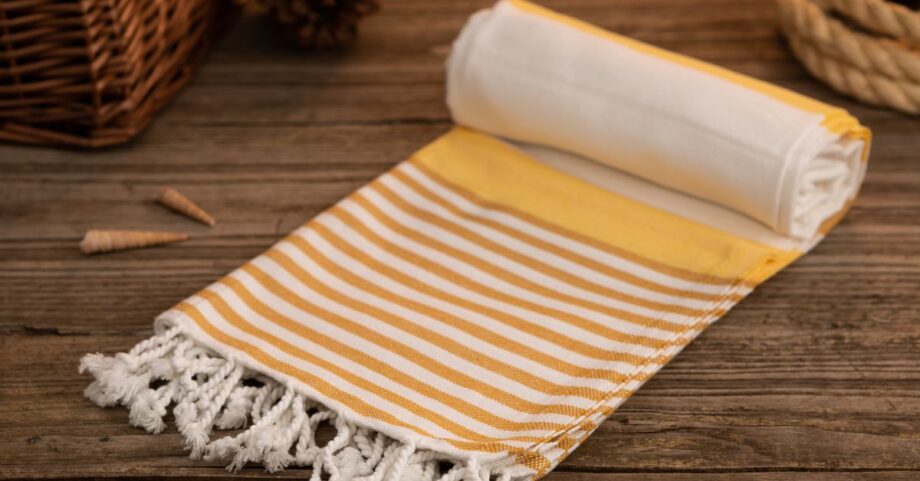Turkish towels are renowned for their unique ability to dry faster than ordinary cotton towels.
Their super absorbency and quick-drying nature come from several factors in their construction, weave pattern, and material. Let’s understand the science of quick drying better:
6 Reasons Turkish Beach Towels Dry Fast:

1. Material
Turkish towels are typically made from cotton. Cotton is a versatile natural fiber that absorbs water well. Its hollow fibers can pull water molecules inside them, helping cotton fabrics like towels take in large amounts of liquid quickly.
Furthermore, cotton enables better moisture wicking, leading to the towel also drying quickly after it absorbed water. Some synthetics might dry faster initially but tend to retain odor or bacteria more over time. Thicker materials like wool stay wet longer as the density makes it hard for water to travel through the fibers to the surface.
| Fiber | Absorption Rate | Drying Time |
| Cotton | High | Quick |
| Synthetic | Medium | Fast initially but retains moisture |
| Wool | Low | Slow due to density |
Turkish towels’ loose weave and thinner cotton yarns allow water to penetrate deep inside the material. Thinner yarns create more tiny capillaries that pull water in from the surface, resulting in cotton’s fast-absorbing quality compared to denser fabrics like wool.
2. Weave
Turkish towels are known for their quick drying ability due to their absorbent cotton material and weave construction. The weave plays an important role in effective moisture management.
Turkish towels use a plain/balanced weave construction, which involves:
- An over-one, under-one interlacing pattern of the warp and weft yarns to form a stable base fabric
- A lower yarn count per inch (6-8 picks per inch or PPI) compared to other woven fabrics
This lower PPI count results in some key characteristics:
- The warp and weft yarns are spaced farther apart
- This wider inter-yarn spacing creates larger openings or “repeats” between the woven strands
At a microscopic level, these repeats act as capillaries that allow for:
- Wicking of water upward quickly through capillary action
- Dispersal of water across more yarn surface area, enabling faster vaporization
| Woven Fabric | Picks per Inch (PPI) | Repeats | Effect on Drying |
| Turkish towel | 6-8 PPI | Larger | Optimizes airflow and evaporation |
| Denser towel | Over 20 PPI | Smaller | Restricts water movement and traps moisture |
Moreover, their weave pattern makes Turkish towels somewhat sand-resistant as well.
3. Absorbency
Cotton, known for its high absorbency, is a key reason Turkish beach towels dry fast. These towels are typically made from cotton, with a porous structure and a high surface area-to-volume ratio. This allows them to soak up water quickly and efficiently, leaving less moisture in the fibers to evaporate slowly.
When the towel pulls water away from your skin, it stores the water in its fibers rather than leaving it on the surface. As a result, Turkish towels can absorb more water and release it faster, speeding up the drying process.
- Cotton’s porous structure allows for faster wicking.
- A high surface area to volume ratio enhances absorption.
- Less water left behind means quicker evaporation.
4. Fabric Thickness
Another factor contributing to the fast-drying nature of Turkish beach towels is their fabric thickness. These towels are designed to be thinner than traditional, bulkier towels.
Thinner fabrics have fewer fibers and air spaces where water can get trapped. Since there is less insulation, heat can pass through faster, leading to faster water evaporation.
For example, while thicker bath towels can feel plush and soft, they retain water longer, slowly drying them. In contrast, Turkish towels have a lightweight, flat-woven structure that dries faster without sacrificing absorbency.
| Fabric Type | Drying Speed |
| Thick, plush towels | Slower |
| Thin Turkish beach towels | Faster |
5. Natural Fibers
Turkish beach towels are primarily made from natural fibers like cotton, which dry faster than synthetic fabrics. Synthetic materials are hydrophobic, meaning they resist water absorption. This makes them slower to dry as they tend to hold onto moisture.
In contrast, cotton is hydrophilic, which means it naturally attracts water. The fibers in cotton contain hydroxyl groups that bind with water molecules, allowing for better absorption and faster drying.
- Cotton absorbs water faster than synthetic materials.
- Synthetic fabrics like polyester are non-polar and hydrophobic.
- Natural fibers like cotton attract water due to their hydrophilic properties.
Since Turkish towels are crafted from cellulose-based cotton, they absorb water quickly and release it just as fast. This natural fiber’s structure makes Turkish towels a better option for people looking for quick-drying towels.
6. Minimalist Designs
These towels often feature minimalist designs, which help them dry faster compared to heavily decorated towels. Simple designs like stripes or basic geometric patterns use a lighter weave with fewer materials, promoting better airflow and quicker drying.
Towels with complex patterns or embellishments tend to have denser weaves and multiple materials, which can trap water and increase drying time.
- Minimalist designs allow for faster drying due to fewer materials.
- Heavily decorated towels trap water and slow down drying.
- Open weave constructions promote airflow and faster evaporation.
For example, a towel with simple stripes and no heavy embroidery will dry significantly faster than a towel covered in intricate patterns. The minimalist design reduces bulk and material density, allowing air to circulate better and water to evaporate quickly.
Turkish vs. Terry Towels: Which Ones Dry Better?
Let’s compare Turkish beach towels and traditional terry towels regarding specific technical details and drying performance.
| Factor | Turkish Towels | Terry Towels |
| Fabric Weave | Flat weave, lightweight | Looped weave, thick and dense |
| Material | 100% Turkish cotton (long fibers) | Cotton or cotton-blend (short fibers) |
| Thickness | Thin, typically between 300 and 400 GSM | Thick, often over 600 GSM |
| Absorbency | Moderate absorbency (due to thinner weave) | High absorbency (due to thicker fabric) |
| Drying Time | Fast (air flows through easily) | Slow (traps moisture in loops) |
| Mildew Resistance | High (quick drying prevents mildew) | Low (long drying time promotes mildew) |
| Weight | Lightweight (easy to carry) | Heavy (bulky to carry) |
| Best Use | Travel, beach, quick drying situations | Home, spa, bath use |
Key insights from the table:
- Turkish towels use a flat, lightweight weave, making drying faster.
- Turkish cotton’s longer fibers allow more airflow, while terry towels trap moisture in their loops.
- Thinner GSM (grams per square meter) in Turkish towels contributes to quick-drying, while higher GSM in terry towels increases absorbency but slows down drying.
In technical terms, the density and material differences explain why Turkish towels dry faster. Their thin structure allows water to evaporate more efficiently, while Terry towels hold moisture longer due to their thick, looped design.
Turkish towels outperform in drying speed for outdoor, beach, or travel use, whereas Terry towels are better suited for indoor environments where thickness and absorbency matter more than drying speed.
Count on Atribe For The Best Turkish Towels If You Prefer Top Quality & Construction:
Turkish towels are an excellent choice if you seek a fast and effective way to dry off after showers or pools or want an absorbent towel for the beach or exercise.
For those valuing craftsmanship and heritage in their towels, Atribe offers a carefully curated selection of top-quality Turkish towels from trusted artisans. Our towels’ quick-drying power and luxurious softness will have you reaching for them repeatedly.


